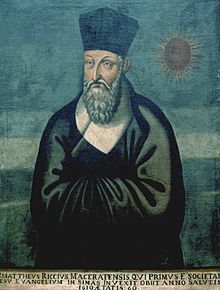
Back ماتيو ريتشي Arabic ماتيو ريتشى ARZ Матэа Рычы Byelorussian Matteo Ricci Catalan Lé Mā-dâiu CDO Matteo Ricci Czech Matteo Ricci German Matteo Ricci Esperanto Matteo Ricci Spanish Matteo Ricci Basque
You can help expand this article with text translated from the corresponding article in Norwegian. (September 2024) Click [show] for important translation instructions.
|
You can help expand this article with text translated from the corresponding article in Chinese. (September 2024) Click [show] for important translation instructions.
|
Matteo Ricci | |
|---|---|
 1610 Chinese portrait of Ricci | |
| Title | Superior General of the China mission |
| Personal | |
| Born | 6 October 1552 |
| Died | 11 May 1610 (aged 57) Beijing, Ming Empire |
| Resting place | Zhalan Cemetery, Beijing |
| Religion | Catholic Church |
| Notable work(s) | Kunyu Wanguo Quantu |
| Organization | |
| Order | Society of Jesus |
| Senior posting | |
| Period in office | 1597–1610 |
| Successor | Nicolò Longobardo |
| Reason for exit | His death |
Matteo Ricci SJ (Italian: [matˈtɛːo ˈrittʃi]; Latin: Matthaeus Riccius; 6 October 1552 – 11 May 1610) was an Italian Jesuit priest and one of the founding figures of the Jesuit China missions. He created the Kunyu Wanguo Quantu, a 1602 map of the world written in Chinese characters. In 2022, the Apostolic See declared its recognition of Ricci's heroic virtues, thereby bestowing upon him the honorific of Venerable.[1]
Ricci arrived at the Portuguese settlement of Macau in 1582 where he began his missionary work in China. He mastered the Chinese language and writing system. He became the first European to enter the Forbidden City of Beijing in 1601 when invited by the Wanli Emperor, who sought his services in matters such as court astronomy and calendrical science. He emphasized parallels between Catholicism and Confucianism but opposed Buddhism. He converted several prominent Chinese officials to Catholicism. He also worked with several Chinese elites, such as Xu Guangqi, in translating Euclid's Elements into Chinese as well as the Confucian classics into Latin for the first time in history.